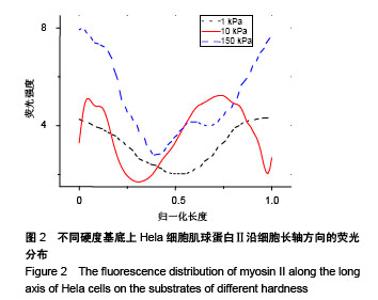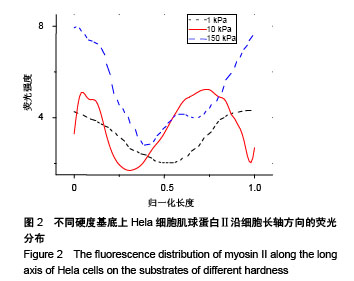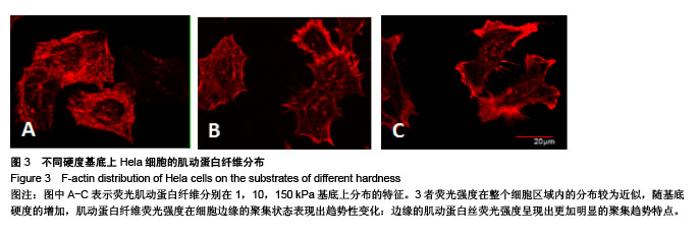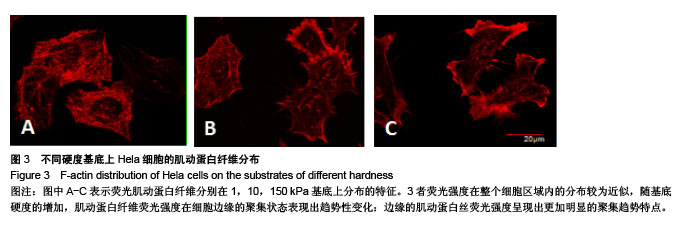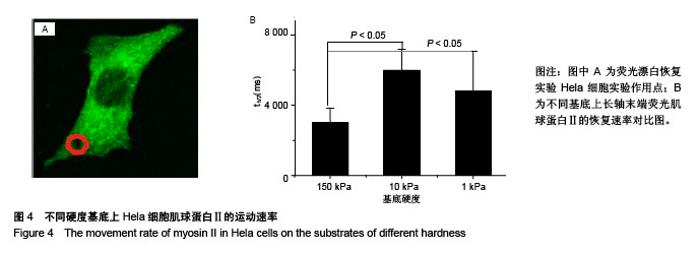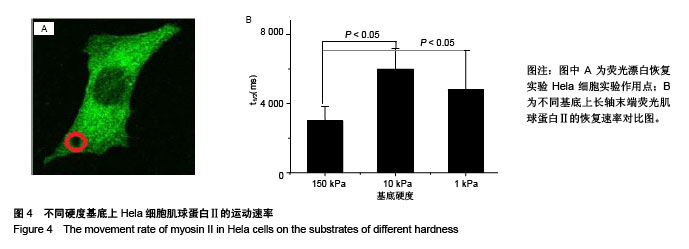Chinese Journal of Tissue Engineering Research
Previous Articles Next Articles
Changes in cytoskeleton proteins and mechanical properties of the cells on soft substrates
Hou Tian, An Mei-wen, Wang Li
- School of Mechanics, Taiyuan University of Technology, Taiyuan 030024, Shanxi Province, China
-
Received:2018-03-15Online:2018-08-08Published:2018-08-08 -
Contact:An Mei-wen, Professor, School of Mechanics, Taiyuan University of Technology, Taiyuan 030024, Shanxi Province, China -
About author:Hou Tian, Master, School of Mechanics, Taiyuan University of Technology, Taiyuan 030024, Shanxi Province, China -
Supported by:the National Natural Science Foundation of China, No. 11372208
CLC Number:
Cite this article
Hou Tian, An Mei-wen, Wang Li . Changes in cytoskeleton proteins and mechanical properties of the cells on soft substrates[J]. Chinese Journal of Tissue Engineering Research, doi: 10.3969/j.issn.2095-4344.0882.
share this article
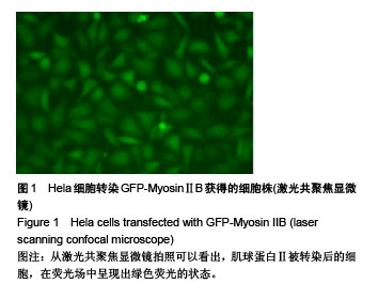
2.1 不同硬度基底上Hela细胞铺展状态下肌球蛋白Ⅱ与肌动蛋白纤维的分布特征 2.1.1 细胞转染GFP-Myosin ⅡB获得的细胞株 见图1。 2.1.2 肌球蛋白Ⅱ沿细胞长轴的分布曲线 肌球蛋白Ⅱ分散于胞浆内,采用共聚焦显微镜测量了Hela细胞核所处层面最低荧光强度的肌球蛋白Ⅱ沿铺展长轴的分布曲线,曲线的纵坐标由荧光强度实测值/荧光强度最小值获得(归一化处理),横坐标轴长由长度/细胞总长(归一化处理)获得。所得曲线经平滑处理,其中按正弦分布的曲线调整了其取向,使得各曲线波峰与波谷的横坐标对应,得到的结果见图2。 从图2可得到,在实验所用3种硬度的弹性基底上,荧光肌球蛋白Ⅱ沿长轴的分布特征呈现出较大差异,所以在后续的实验中重点关注了细胞边缘荧光肌球蛋白Ⅱ的变化。在分布曲线中,在硬度为150 kPa 聚丙烯酰胺凝胶上生长的细胞,边缘荧光强度显著高于其他部分;在10 kPa与1 kPa基底上生长的细胞,基底硬度导致了荧光肌球蛋白Ⅱ在边缘的分布呈现出一定的回落现象。 实验结果表明,随着基底硬度的降低,细胞边缘的荧光肌球蛋白Ⅱ聚集量有下降趋势,这一现象说明荧光肌球蛋白Ⅱ可能与细胞的黏附程度有关。"
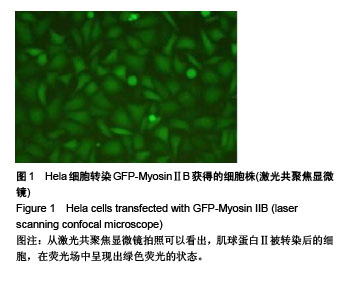
| [1] 温稳,张保平,白仲添,等.杨氏模量及细胞骨架重塑对肝癌细胞侵袭的影响[J].中华消化杂志,2015,35(6):371-376.[2] 温斯健,倪娜娜,周晓伟,等.过表达RhoD对人黑素瘤A375细胞骨架和迁移侵袭的影响[J].中华皮肤科杂志, 2016,49(12):871-875.[3] Cross SE,Jin YS, Rao J,et al.Nanomechanical analysis of cells from cancer patients.Nat Nanotechnol. 2007;2(12):780-783.[4] 李玲珺,李霞.基于微管靶点的抗肿瘤药物研究进展[J].中国药师, 2017, 20(1):139-143.[5] Ulrich TA,de Juan Pardo EM,Kumar S.The mechanical rigidity of the extracellular matrix regulates the structure,motility,and proliferation of glioma cells.Cancer Res. 2009;69(10):4167-4174.[6] Peckham M.How myosin organization of the actin cytoskeleton contributes to the cancer phenotype. Biochem Soc Trans. 2016;44(4): 1026-1034.[7] Lopez JI,Kang I,You WK,et al.In situ force mapping of mammary gland transformation.Integr Biol (Camb). 2011;3(9):910-921.[8] Schrader J,Gordon-Walker TT,Aucott RL,et al.Matrix stiffness modulates proliferation,chemotherapeutic response,and dormancy in hepatocellular carcinoma cells.Hepatology. 2011;53(4):1192-1205.[9] Park J,Kim DH,Kim HN,et al.Directed migration of cancer cells guided by the graded texture of the underlying matrix.Nat Mater. 2016;15(7): 792-801 [10] Tilghman RW,Cowan CR,Mih JD,et al.Matrix rigidity regulates cancer cell growth and cellular phenotype.PLoS One. 2010;5(9):e12905.[11] Paszek MJ,Zahir N,Johnson KR,et al.Tensional homeostasis and the malignant phenotype.Cancer Cell.2005;8(3):241-254.[12] Wang N,Ingber DE.Control of cytoskeletal mechanics by extracellular-matrix, cell-shape,and mechanical tension.Biophys J. 1994;66(6):2181-2189.[13] Tang X,Kuhlenschmidt TB,Zhou J,et al.Mechanical force affects expression of an in vitro metastasis-like phenotype in HCT-8 cells. Biophys J.2010;99(8):2460-2469.[14] Zilman AG,Safran SA.Role of cross-links in bundle formation,phase separation and gelation of long filaments.Europhys Lett. 2003;63(1): 139-145.[15] Besser A,Schwarz US.Coupling biochemistry and mechanics in cell adhesion: a model for inhomogeneous stress fiber contraction.New J Physics.2007;9(11):427-451.[16] 石小川,沈超,聂巍,等.非肌肉Ⅱ型肌球蛋白在细胞骨架网络中动力学行为的图像分析[J].生物化学与生物物理进展, 2016,43(3):244-255.[17] Discher DE,Janmey P,Wang YL.Tissue cells feel and respond to the stiffness of their substrate. Science. 2005;310(18):1139-1143.[18] Yeung T,Georges PC,Flanagan LA,et al.Effects of substrate stiffness on cell morphology,cytoskeletal structure,and adhesion.Cell Motil Cytoskeleton.2005;60(1):24-34.[19] Shutova M,Yang C,Vasiliev JM,et al.Functions of nonmuscle myosin Ⅱ in assembly of the cellular contractile system.PLoS One. 2012; 7(7):e40814.[20] Ridley AJ.Rho GTPase signalling in cell migration.Curr Opin Cell Biol. 2015;36:103-112.[21] Brown TD,Pedersen DR,Baker KJ,et al.Mechanical consequences of core drilling and bone grafting on osteonecrosis of the femoral head. Bone Joint Surg Am. 1993;75(9):1358-1367.[22] Engler AJ,Sen S,Sweeney HL,et al.Matrix Elasticity Directs Stem Cell Lineage Specification.Cell.2006;44(6):677-689.[23] Ingber DE.Tensegrity II.How structural networks influence cellular information processing networks.J Cell Sci. 2003;116(Pt 8):1397-408. [24] Wei Q,Adelstein RS.Conditional expression of a truncated fragment of nonmuscle myosin Ⅱ-A alters cell shape but not cytokinesis in HeLa cells.Mol Biol Cell. 2000;11(10):3617-3627.[25] Beningo KA,Lo CM,Wang YL.Flexible polyacrylamide substrata for the analysis of mechanical interactions at cellsubstratum adhesions. Methods Cell Biol. 2002;69:325-339.[26] Zhang Q,Wang X,Wei X.Characterization of viscoelastic properties of normal and osteoarthritic chondrocytes in experimental rabbit model. Osteoarthritis Cartilage. 2008;16(7):837-840.[27] 徐晋斌,樊学军,张火圣,等.微管吸吮和半无限体模型在鼠成骨细胞粘弹性研究中的应用[J].生物物理学报,1998,14(2):360-367.[28] Senapati SK,Pal S.UHMWPE-alumina ceramic composite: A proposed metal substitute for artificially replaced hip Joint.J Inst Eng(India). 2005; 85:157-162.[29] Zhu Y,Yan ZQ,Shen BR,et al.Effect of Akt/PKB activation on mechanical strain-induced vascular smooth muscle cell migration.J Med Biomech.2006;21(4):259-261.[30] Xu BY,Song GB.Advances in selective differentiation of bone marrow mesenchymal stem cells induced by mechanical stimulation.J Med Biomech.2007;22(1):104-108.[31] Zhou T,Wang CH,Yan H,et al.Inhibition of the Rac1-WAVE2-Arp2/3 signaling pathway promotes radiosensitivity via downregulation of cofilin-1 in U251 human glioma cells.Mol Med Rep. 2016;13(5): 4414-4420.[32] Carlson RO.New tubulin targeting agents currently in clinical development.Expert Opin Investig Drugs.2008;17(5):707-722[33] Ulrich T A,de Juan Pardo E M, Kumar S. The mechanical rigidity of the extracellular matrix regulates the structure, motility,and proliferation of glioma cells.Cancer Res. 2009;69(10):4167-4174.[34] Tilghman RW,Blais EM,Cowan CR,et al.Matrix rigidity regulates cancer cell growth by modulating cellular metabolismand protein synthesis. PLoS One. 2012;7(5):e37231.[35] Lu P,Weaver VM,Werb Z.The extracellular matrix: a dynamic niche in cancer progression.J Cell Biol. 2012;196(4):395-406.[36] Paszek MJ,Zahir N,Johnson KR,et al.Tensional homeostasis and the malignant phenotype.Cancer Cell.2005;8(3):241.[37] Levental KR,Yu H,Kass L,et al.Matrix Crosslinking Forces Tumor Progression by Enhancing Integrin signaling.Cell. 2009;139(5): 891-906.[38] Paszek MJ,Zahir N,Johnson KR,et al.Supplemental data Tensional homeostasis and the malignant phenotype.Cancer Cell. 2005;10(6): 121-124.[39] Tilghman RW,Cowan CR,Mih JD,et al.Matrix Rigidity Regulates Cancer Cell Growth and Cellular Phenotype.PloS One. 2010;5(9): e12905.[40] Tang X,Kuhlenschmidt TB,Zhou J,et al.Mechanical force affects expression of an in vitro metastasis-like phenotype in HCT-8 cells. Biophys J.2010;99(8):2460. [41] Cheffings TH,Burroughs NJ,Balasubramanian MK. Actomyosin Ring Formation and Tension Generation in Eukaryotic Cytokinesis.Curr Biol. 2016;26(15):719-737.[42] Matsuoka T,Yashiro M.Rho/ROCK signaling in motility and metastasis of gastric cancer.World J Gastroenterol. 2014;20(38):13756-13766.[43] Martin SK,Kamelgarn M,Kyprianou N.Cytoskeleton targeting value in prostate cancer treatment. Am J Clin Exp Urol. 2014;2(1):15-26.[44] Wang W,Eddy R,Condeelis J.The cofilin pathway in breast cancer invasion and metastasis. Nat Rev Cancer. 2007;7(6):429-440.[45] Zhang Q,Liao X,Tang W,et al.Adhesion of nasopharyngeal carcinoma cells to hyaluronic acid and morphological observation of microfilament bylLaser confo cal scanning microscopy.Chin J Histochem Cytochem. 1997;6(1):82-86.[46] Shih JY,Lee YC,Yang SC,et al.Collapsin response mediator protein-1:a novel invasion-suppressor gene.Clin Exp Metastasis.2003;20(1):69-76 |
| [1] | Zhang Tongtong, Wang Zhonghua, Wen Jie, Song Yuxin, Liu Lin. Application of three-dimensional printing model in surgical resection and reconstruction of cervical tumor [J]. Chinese Journal of Tissue Engineering Research, 2021, 25(9): 1335-1339. |
| [2] | Zeng Yanhua, Hao Yanlei. In vitro culture and purification of Schwann cells: a systematic review [J]. Chinese Journal of Tissue Engineering Research, 2021, 25(7): 1135-1141. |
| [3] | Xu Dongzi, Zhang Ting, Ouyang Zhaolian. The global competitive situation of cardiac tissue engineering based on patent analysis [J]. Chinese Journal of Tissue Engineering Research, 2021, 25(5): 807-812. |
| [4] | Wu Zijian, Hu Zhaoduan, Xie Youqiong, Wang Feng, Li Jia, Li Bocun, Cai Guowei, Peng Rui. Three-dimensional printing technology and bone tissue engineering research: literature metrology and visual analysis of research hotspots [J]. Chinese Journal of Tissue Engineering Research, 2021, 25(4): 564-569. |
| [5] | Chang Wenliao, Zhao Jie, Sun Xiaoliang, Wang Kun, Wu Guofeng, Zhou Jian, Li Shuxiang, Sun Han. Material selection, theoretical design and biomimetic function of artificial periosteum [J]. Chinese Journal of Tissue Engineering Research, 2021, 25(4): 600-606. |
| [6] | Liu Fei, Cui Yutao, Liu He. Advantages and problems of local antibiotic delivery system in the treatment of osteomyelitis [J]. Chinese Journal of Tissue Engineering Research, 2021, 25(4): 614-620. |
| [7] | Li Xiaozhuang, Duan Hao, Wang Weizhou, Tang Zhihong, Wang Yanghao, He Fei. Application of bone tissue engineering materials in the treatment of bone defect diseases in vivo [J]. Chinese Journal of Tissue Engineering Research, 2021, 25(4): 626-631. |
| [8] | Zhang Zhenkun, Li Zhe, Li Ya, Wang Yingying, Wang Yaping, Zhou Xinkui, Ma Shanshan, Guan Fangxia. Application of alginate based hydrogels/dressings in wound healing: sustained, dynamic and sequential release [J]. Chinese Journal of Tissue Engineering Research, 2021, 25(4): 638-643. |
| [9] | Chen Jiana, Qiu Yanling, Nie Minhai, Liu Xuqian. Tissue engineering scaffolds in repairing oral and maxillofacial soft tissue defects [J]. Chinese Journal of Tissue Engineering Research, 2021, 25(4): 644-650. |
| [10] | Xing Hao, Zhang Yonghong, Wang Dong. Advantages and disadvantages of repairing large-segment bone defect [J]. Chinese Journal of Tissue Engineering Research, 2021, 25(3): 426-430. |
| [11] | Chen Siqi, Xian Debin, Xu Rongsheng, Qin Zhongjie, Zhang Lei, Xia Delin. Effects of bone marrow mesenchymal stem cells and human umbilical vein endothelial cells combined with hydroxyapatite-tricalcium phosphate scaffolds on early angiogenesis in skull defect repair in rats [J]. Chinese Journal of Tissue Engineering Research, 2021, 25(22): 3458-3465. |
| [12] | Wang Hao, Chen Mingxue, Li Junkang, Luo Xujiang, Peng Liqing, Li Huo, Huang Bo, Tian Guangzhao, Liu Shuyun, Sui Xiang, Huang Jingxiang, Guo Quanyi, Lu Xiaobo. Decellularized porcine skin matrix for tissue-engineered meniscus scaffold [J]. Chinese Journal of Tissue Engineering Research, 2021, 25(22): 3473-3478. |
| [13] | Mo Jianling, He Shaoru, Feng Bowen, Jian Minqiao, Zhang Xiaohui, Liu Caisheng, Liang Yijing, Liu Yumei, Chen Liang, Zhou Haiyu, Liu Yanhui. Forming prevascularized cell sheets and the expression of angiogenesis-related factors [J]. Chinese Journal of Tissue Engineering Research, 2021, 25(22): 3479-3486. |
| [14] | Liu Chang, Li Datong, Liu Yuan, Kong Lingbo, Guo Rui, Yang Lixue, Hao Dingjun, He Baorong. Poor efficacy after vertebral augmentation surgery of acute symptomatic thoracolumbar osteoporotic compression fracture: relationship with bone cement, bone mineral density, and adjacent fractures [J]. Chinese Journal of Tissue Engineering Research, 2021, 25(22): 3510-3516. |
| [15] | Liu Liyong, Zhou Lei. Research and development status and development trend of hydrogel in tissue engineering based on patent information [J]. Chinese Journal of Tissue Engineering Research, 2021, 25(22): 3527-3533. |
| Viewed | ||||||
|
Full text |
|
|||||
|
Abstract |
|
|||||
